How did COVID-19 affect the incomes of migrants and low-wage workers in India?
by Kritika Shukla, Mohak Srivastava and Vedika Tibrewala
May 28, 2021
3 min
The case study is about the impact of the COVID-19 pandemic and the resulting lockdowns on migrants and the low-income group in India. It captures stories of migrants who were stranded away from their homes without any livelihood. The case study also highlights the adverse effects of the pandemic on the income and jobs of daily wage workers.
According to India’s most recent census conducted in 2011, the country is home to 456 million migrants who represent 38% of the total population. The first lockdown to curb the spread of COVID-19 left these migrants stranded in their host communities and desperate to return to their familial homes.[1] Stories of households that lost livelihoods and families that walked hundreds of kilometers to reach their villages dominated the news. Even after reaching their native homes, the dearth of employment opportunities in villages offered migrants little solace.
MSC (MicroSave Consulting) undertook a mixed-method study[2] to understand the impact of COVID-19 on the earnings of low-income households and evaluate the government’s COVID-19 relief package, Pradhan Mantri Garib Kalyan Yojana (PMGKY). We conducted the first phase of the study during the three-month complete lockdown in May, 2020 and the second phase after the relaxation in lockdown norms in September, 2020. The studies covered 5,081 households across 18 states and union territories in each phase, with 4,082 households common to both rounds.
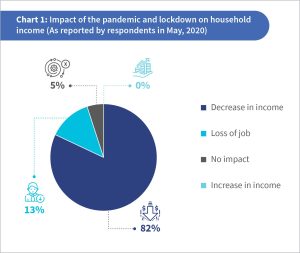
In the first phase of MSC’s study, households across all occupations reported a drop in household income. Chart 1 illustrates the impact of the lockdown on the income of those surveyed. The impact was much more pronounced in May as compared to September, 2020. In May, 82% of households reported a reduction in income.
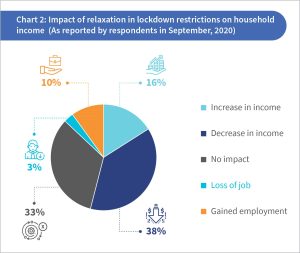
When asked about their status of employment, the responses corroborated the findings mentioned above. In Round 1, 13% of households reported losing their jobs during the lockdown. This percentage fell to 3% in Round 2 and 10% of the households stated that they regained employment.
Due to loss of income, most families had to find other ways to sustain themselves. Many households reported that government benefits helped them stay afloat.
Households reported that circumstances forced them to take loans either from friends and family or from informal money lenders. They repurposed existing loans from self-help groups, banks, and microfinance institutions to manage expenses. People also reported positive experiences with their landlords or money lenders who agreed to delay or forgo rents and interest during the lockdown.
The pandemic had manifold impacts on migrants who depend on daily wages to survive and support their families. These migrants typically work as wage laborers in various industries. The shutdown of these industries due to the lockdown left migrants without any income, which made it difficult for them to pay for food or rent. The Government of India (GoI) did not issue any guidelines to mandate these industries to provide laborers with accommodation or food.
To mitigate the adverse impact on income, GoI launched various government-to-citizen (G2C) payments and in-kind assistance under the umbrella of the Pradhan Mantri Garib Kalyan Yojana (PMGKY). The Finance Minister also announced that the government would allocate USD 468 million (INR 35 billion) to feed stranded migrants. The government further arranged Shramik trains to take migrants back to their native homes. Additionally, in June, 2020, the GoI launched the Garib Kalyan Rojgar Abhiyan across 116 districts in the states of Bihar, Uttar Pradesh, Madhya Pradesh, Rajasthan, Jharkhand, and Odisha to boost employment and livelihood opportunities. This program, with a total expenditure of about USD 5.6 billion (INR 392.93 billion), generated 507,868,671 person-days of employment between March and July, 2020. MSC assessed the impact of all programs under PMGKY and made recommendations on the way forward for each program to shoulder future crises in a series of publications.[3]
The next blog in this series examines the impact of increased allocation to the MNREGA[4] program as part of the GoI’s efforts to support returning migrants by commissioning public works in their villages.
[1] Details of the effect of the pandemic and lockdown on migrants can be found here.
[2] Detail methodology can be read here.
[3] MSC has a series of publications on the impact of the various programs under PMGKY—PDS, PMUY, and MGNREGA, as well as other cash transfer programs—NSAP, PMJDY and PM Kisan.
[4] MGNREGA (Mahatma Gandhi National Rural Employment Guarantee Act) is a social security program of the GoI that guarantees at least 100 days of employment per year to unemployed, low-skilled workers.
 by
by  May 28, 2021
May 28, 2021 3 min
3 min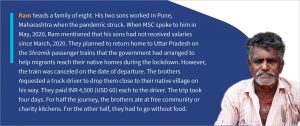
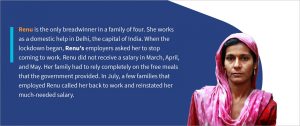
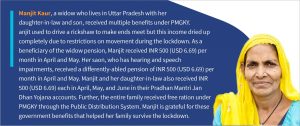




Leave comments